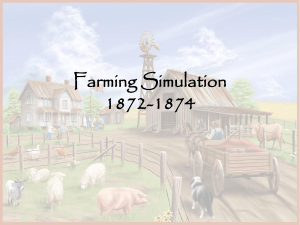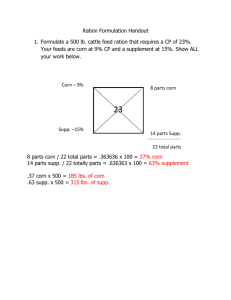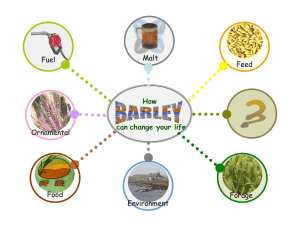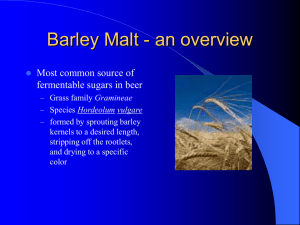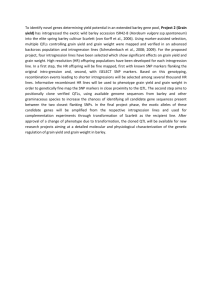Barley - Agriculture
advertisement
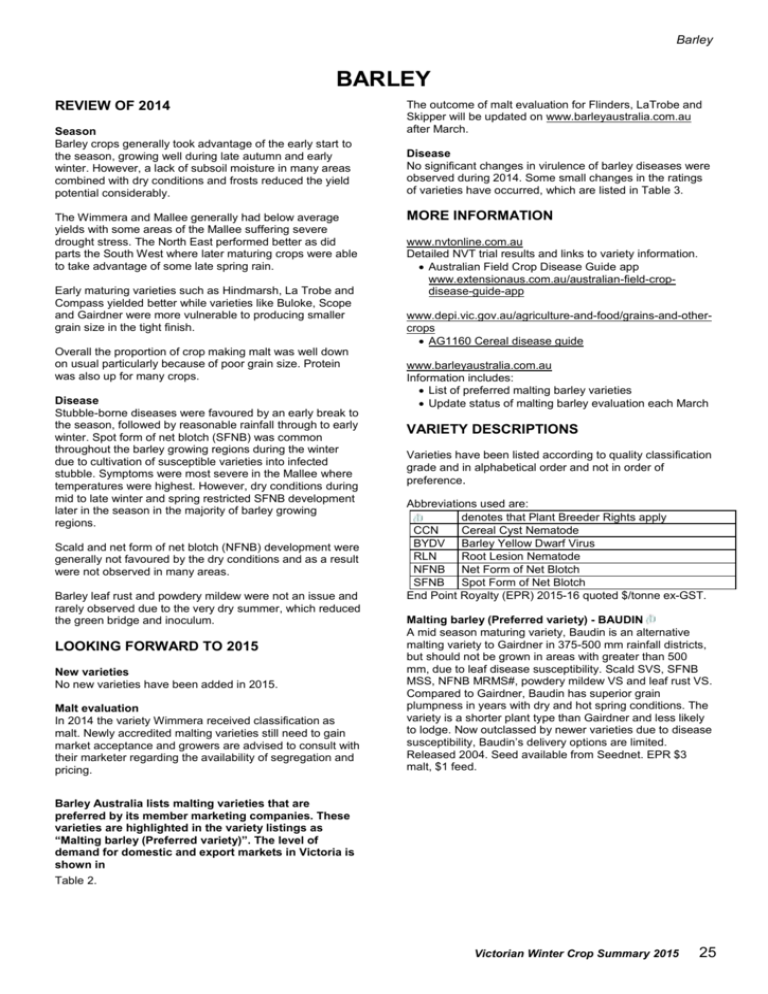
Barley BARLEY REVIEW OF 2014 Season Barley crops generally took advantage of the early start to the season, growing well during late autumn and early winter. However, a lack of subsoil moisture in many areas combined with dry conditions and frosts reduced the yield potential considerably. The Wimmera and Mallee generally had below average yields with some areas of the Mallee suffering severe drought stress. The North East performed better as did parts the South West where later maturing crops were able to take advantage of some late spring rain. Early maturing varieties such as Hindmarsh, La Trobe and Compass yielded better while varieties like Buloke, Scope and Gairdner were more vulnerable to producing smaller grain size in the tight finish. Overall the proportion of crop making malt was well down on usual particularly because of poor grain size. Protein was also up for many crops. Disease Stubble-borne diseases were favoured by an early break to the season, followed by reasonable rainfall through to early winter. Spot form of net blotch (SFNB) was common throughout the barley growing regions during the winter due to cultivation of susceptible varieties into infected stubble. Symptoms were most severe in the Mallee where temperatures were highest. However, dry conditions during mid to late winter and spring restricted SFNB development later in the season in the majority of barley growing regions. Scald and net form of net blotch (NFNB) development were generally not favoured by the dry conditions and as a result were not observed in many areas. Barley leaf rust and powdery mildew were not an issue and rarely observed due to the very dry summer, which reduced the green bridge and inoculum. LOOKING FORWARD TO 2015 New varieties No new varieties have been added in 2015. Malt evaluation In 2014 the variety Wimmera received classification as malt. Newly accredited malting varieties still need to gain market acceptance and growers are advised to consult with their marketer regarding the availability of segregation and pricing. The outcome of malt evaluation for Flinders, LaTrobe and Skipper will be updated on www.barleyaustralia.com.au after March. Disease No significant changes in virulence of barley diseases were observed during 2014. Some small changes in the ratings of varieties have occurred, which are listed in Table 3. MORE INFORMATION www.nvtonline.com.au Detailed NVT trial results and links to variety information. Australian Field Crop Disease Guide app www.extensionaus.com.au/australian-field-cropdisease-guide-app www.depi.vic.gov.au/agriculture-and-food/grains-and-othercrops AG1160 Cereal disease guide www.barleyaustralia.com.au Information includes: List of preferred malting barley varieties Update status of malting barley evaluation each March VARIETY DESCRIPTIONS Varieties have been listed according to quality classification grade and in alphabetical order and not in order of preference. Abbreviations used are: denotes that Plant Breeder Rights apply CCN Cereal Cyst Nematode BYDV Barley Yellow Dwarf Virus RLN Root Lesion Nematode NFNB Net Form of Net Blotch SFNB Spot Form of Net Blotch End Point Royalty (EPR) 2015-16 quoted $/tonne ex-GST. Malting barley (Preferred variety) - BAUDIN A mid season maturing variety, Baudin is an alternative malting variety to Gairdner in 375-500 mm rainfall districts, but should not be grown in areas with greater than 500 mm, due to leaf disease susceptibility. Scald SVS, SFNB MSS, NFNB MRMS#, powdery mildew VS and leaf rust VS. Compared to Gairdner, Baudin has superior grain plumpness in years with dry and hot spring conditions. The variety is a shorter plant type than Gairdner and less likely to lodge. Now outclassed by newer varieties due to disease susceptibility, Baudin’s delivery options are limited. Released 2004. Seed available from Seednet. EPR $3 malt, $1 feed. Barley Australia lists malting varieties that are preferred by its member marketing companies. These varieties are highlighted in the variety listings as “Malting barley (Preferred variety)”. The level of demand for domestic and export markets in Victoria is shown in Table 2. Victorian Winter Crop Summary 2015 25 Barley Malting barley (Preferred variety) - BULOKE An early to mid season maturing variety best adapted to regions of southern Australia with 325-450 mm annual rainfall. Moderately tall with moderately weak straw strength, similar to Gairdner, and can be prone to significant head loss under unfavourable conditions postmaturation. Buloke has a similar level of tolerance to preharvest sprouting to Gairdner. Average grain plumpness is similar or slightly inferior to Baudin but superior to Gairdner. Scald MS, SFNB S, NFNB MR, powdery mildew MR and leaf rust SVS. Whilst Buloke yields well in Mallee environments, it should only be grown in CCN prone environments if the majority of other crops/varieties in the rotation are CCN resistant. In Victoria, Buloke is considered mid-season maturity earlier than Gairdner, but later than Hindmarsh. Buloke has export malt quality similar to Baudin. Released 2005. Seed available from Seednet. EPR $2. Limagrain and seed available from Heritage Seeds. EPR $2.95. Malting barley (Preferred variety) - COMMANDER A mid maturing variety best suited to 375-500 mm rainfall districts, particularly the Wimmera Mallee. It is broadly adapted and will outyield other varieties under favourable spring conditions. Commander is inherently lower in grain protein content like Buloke and Scope. It has moderately weak straw and can lodge under either high yield environments or if unfavourable conditions occur between grain filling and harvest. Grain size is superior to many other malting barley varieties but it is prone to low test weights in some seasons. Scald S, SFNB & NFNB MSS, powdery mildew MRMS and leaf rust S. Commander is acceptable for domestic, Chinese, and SE Asian brewing markets. Growers should consult their grain marketers regarding markets and availability of segregation for this variety. Released 2008. Seed available from Seednet. EPR $3.80. Malting barley (Preferred variety) - SCOPE CL A tall, early to mid season maturing barley with moderate to high yield potential across a range of medium rainfall environments. Its disease resistance profile is very similar to Buloke with the main concern being susceptibility to some leaf rust strains. Scald MSS, SFNB MSS, NFNB MR, powdery mildew R# and leaf rust SVS. Scope shares the lodging, headloss, grain size and protein characteristics of Buloke. Scope is the only barley variety registered for the use of an appropriate Clearfield herbicide. Accredited as malting barley in 2013, export markets are yet to be established so growers are advised to consult with their grain marketer about segregation and pricing. Although developed from a Buloke mutation, Barley Australia have not authorised co-binning with Buloke. It is considered a different variety to Buloke and legally needs to be declared as such. In the longer term, Scope is expected to be accepted into those markets currently accepting Buloke. Released 2010. Seed is available from Seednet exclusively through re-sellers that have a current Clearfield accreditation. EPR $3.50. Malting barley - FAIRVIEW A moderately late maturing variety best suited to 400-600 mm rainfall districts. Yields are similar to Gairdner and Commander in these districts. The grain plumpness of Fairview is superior to Gairdner. Limited seed is only available under contract through GrainSearch, Geelong. Released 2008. Fairview has an export malt quality profile and is marketed via closed loop supply chain through Malteurop. EPR $3. Malting barley (Preferred variety) - GAIRDNER A moderately late maturing variety best suited to 400-600 mm rainfall regions. In lower rainfall districts Gairdner can yield well in seasons with favourable spring finishes, however not necessarily within malting specifications. Scald SVS, SFNB S, NFNB MRMS, powdery mildew S and leaf rust S. Gairdner is known for high screenings in a dry spring, with the levels of grain plumpness for Gairdner generally being inferior to all other malting varieties. Gairdner has moderately good head retention, slightly inferior to Baudin. Gairdner is accepted by both domestic and export brewing markets. Released 1998. Seed available from Heritage Seeds. No EPR. Malting barley - GRANGER A mid to late maturing variety with strong straw, and good kernel plumpness and low screenings. Scald S, SFNB SVS, NFNB MS, powdery mildew MR and leaf rust MR#. Accredited as malting barley in 2013, export markets are yet to be established and growers are advised to consult with their grain marketer about segregation and pricing. Released 2013. Tested as SMBA09-3353. Licenced by 26 Victorian Winter Crop Summary 2015 Malting barley (Preferred variety) – NAVIGATOR A mid to late maturing variety similar to Gairdner but offering higher yield potential, significantly improved physical grain quality and an excellent disease resistance profile with the exception of being very susceptible to leaf rust. Scald MRMS, SFNB MRMS, NFNB MR#, powdery mildew R and leaf rust VS. Navigator is an accredited malting variety primarily suited for use by the domestic brewing industry. Due to the current small market size for Navigator as a malting variety, growers should seek advice from their grain marketer regarding availability of segregation and pricing prior to sowing this variety and will be best suited to growers with freight advantage to local malthouses. Released 2011. Seed available from Seednet. EPR $3.80 Malting barley (Preferred variety) - WESTMINSTER A mid to late maturity variety with medium to tall and stiff straw and improved head retention. Scald R#, SFNB S, NFNB MSS, powdery mildew R and leaf rust MRMS. Accredited as malting barley in 2013, export markets are yet to be established and growers are advised to consult with their grain marketer about segregation and pricing. It was bred by Limagrain, released 2009, and is marketed through Grainsearch. EPR $3. Malting barley - WIMMERA Wimmera is a mid to late maturing variety with similar plant architecture to Gairdner and significantly higher yield potential and improved scald and leaf rust resistance. Scald MSS, SFNB S, NFNB MSS, powdery mildew S and leaf rust MR#. In long-term NVT trials, Wimmera has a 10% average yield advantage over Gairdner in all areas other than the Mallee. Wimmera has lower screenings and higher retention than Gairdner, with equivalent test weight. Wimmera is an accredited malting variety suited to a range of domestic and export markets, Released 2011. Wimmera is currently undergoing further market development. Barley Feed barley - CAPSTAN Capstan is a high yielding feed variety recommended for 400mm plus rainfall regions. Capstan has short stiff straw with excellent head retention and would be suitable for growers targeting very high potential yields. It has very high screenings in lower rainfall districts. Scald S, SFNB MS, NFNB MSS, powdery mildew MR and leaf rust MRMS. Released 2003. Seed available from Seednet. No EPR. Feed barley - FATHOM An early maturing variety with broad adaption and consistently high yields. It has very low screenings, similar to Maritime and a higher test weight than Fleet. Fathom has a long coleoptile and early vigour giving weed competitiveness and tolerance to deep planting and sandy soils. Fathom is well suited to wider row spacings and is an alternative to Hindmarsh particularly where more reliable establishment and improved early vigour are sought. Fathom is moderately tall with head loss and lodging resistance. Scald MR#, SFNB MR, NFNB MS, powdery mildew MRMS and leaf rust MSS. Released 2011. Seed available from Seednet. EPR $2. Feed barley - FLEET Best suited to 325-400 mm rainfall regions as an alternative to Hindmarsh and Keel. Fleet has superior adaptation to deep sandy soils compared to Hindmarsh and Keel due to a relatively long coleoptile that makes Fleet more tolerant of deeper sowing. Scald MSS, SFNB MR, NFNB MRMS#, powdery mildew MR and leaf rust MSS. Some pathotypes of NFNB now show increased virulence on Fleet. Fleet has improved physical grain quality compared to Keel but has lower test weight than Hindmarsh. Fleet is highly prone to lodging but has good head retention. Released 2004. Seed available from Seednet. EPR $1.50. Feed / Food barley - HINDMARSH An early maturing semi-dwarf feed variety with exceptional yield potential, especially in drier years. It is recommended for the 325-450 mm rainfall regions. Hindmarsh was the highest yielding barley variety in the Mallee and Wimmera in NVT long term trials for 2008-12. Hindmarsh has a relatively short coleoptile and deep sowing should be avoided to maximise crop establishment and yield potential. Scald SVS, SFNB SVS, NFNB MR, powdery mildew MRMS# and leaf rust MSS. Hindmarsh is free threshing and has good resistance to head loss. Hindmarsh has excellent grain plumpness and also has the highest test weight of any feed variety. Released by the forerunner of DEDJTR in 2006. Seed available from Seednet. EPR $1.50. Feed barley - KEEL A high yielding, very early maturing, feed variety recommended for the 325-400 mm rainfall regions. Due to Keel’s very early maturity, it can be prone to frost damage if sown too early. It performs best on heavy soil types with low fertility. Keel is not suitable for sandy soils, where Fleet or Fathom are preferred. Keel produces plump grain similar to Fleet and Fathom, along with low screenings; however, similar to Fleet, Keel has low test weight. Keel is a shorter plant type compared to Fleet and Fathom, has good head retention and is free-threshing. Scald MS, SFNB MR, NFNB MR#, powdery mildew MS and leaf rust VS. Released 1999. Seed available from Seednet. No EPR. Feed barley - OXFORD A feed variety best suited to medium to high rainfall regions (350-600 mm) and should not be planted after mid-June. Scald MSS#, SFNB S, NFNB MS, powdery mildew R and leaf rust MR. Oxford was bred by Limagrain, released 2009 and seed is available from Heritage Seeds. EPR $2.50. VARIETIES CURRENTLY UNDERGOING MALT EVALUATION Barley under evaluation - COMPASS Compass is an early to mid maturing variety, agronomically similar to Commander, It is very high yielding and broadly adapted, with excellent grain size and test weight. Compass has been released as a feed variety for 2015, and is also undergoing malting evaluation with a decision expected in March 2016. The malting quality profile will be suited to domestic and export malting and brewing markets currently utilising Gairdner and Commander. Scald MS#, SFNB MSS, NFNB MR#, powdery mildew MR#. Bred by the University of Adelaide and tested as WI4593. Seed available from Seednet. EPR $3.80. Barley under evaluation - FLINDERS A moderately late maturing variety. Moderately short with stiff, strong straw and good head retention. It has high levels of grain plumpness and good test weights. Scald S, SFNB & NFNB S, powdery mildew RMR and leaf rust MS. While not as high yielding as the earlier maturing LaTrobe or Compass, Flinders offers a replacement for Baudin and Gairdner with a longer season option and will be available pending final malt accreditation. Developed by InterGrain. Released 2012, it is currently undergoing malting evaluation with a decision expected in March 2015. Seed available from Syngenta. EPR $3.80. Barley under evaluation - LATROBE An early maturing variety for the low to medium rainfall environments. A semi-dwarf with a short coleoptile, good lodging resistance and good head retention. Good sprouting tolerance, but reduced weed competitiveness. It has high levels of grain plumpness and good test weights. Scald VS, SFNB S, NFNB MR, powdery mildew MRMS# and leaf rust MSS. Developed by InterGrain (as IGB1101). It is currently undergoing malting evaluation with a decision expected in March 2015. Seed available from Syngenta. EPR $4. Barley under evaluation - SKIPPER An early to mid maturing malting quality variety similar in maturity and plant type to Hindmarsh. Skipper is best adapted to mid and low rainfall environments. Relative to many other malting varieties, Skipper has high levels of grain plumpness and low levels of screenings being similar to Commander, but poor straw stength compared to other malt varieties. Scald S, SFNB MRMS, NFNB MR, powdery mildew MR and leaf rust SVS. Released 2011, it is currently undergoing malting evaluation with a decision expected in March 2015. EPR to be determined. Barley under evaluation - SY RATTLER SY Rattler is a late maturing variety recommended for the high rainfall, 450-600mm regions. SY Rattler is undergoing the early stages of malt and brewing evaluation. Bred by Syngenta. Released in 2012, it is currently undergoing malting evaluation with a decision expected in March 2017. Seed available from Grainsearch. EPR $3. Victorian Winter Crop Summary 2015 27 Barley Table 1: Barley time of sowing guide. This table is a guide only and has been compiled from observations of the breeder and local departmental agronomists. MALLEE April May June July Baudin, Gairdner, Wimmera > X X X X X < < Commander, Compass, Fathom, Fleet, Keel > X X X X X X < < < Buloke, Hindmarsh, LaTrobe, Scope, Skipper > > X X X X X < < WIMMERA April May June July Flinders, Gairdner, GrangeR, Navigator, Oxford, Wimmera > X X X X X < < Keel > > X X X X X X X < < Baudin, Fleet > > X X X X X X < < Fathom, Hindmarsh, LaTrobe, Skipper > X X X X X X X < < Buloke, Commander, Compass, Scope > X X X X X < < NORTH CENTRAL April May June July Flinders, Gairdner, GrangeR, Navigator, Wimmera > > X X X X X X < < Fleet > > > X X X X X < < Buloke, Commander, Compass, Scope > > X X X X < < Fathom, Hindmarsh, LaTrobe, Skipper > X X X X X X X X X < Keel > > X X X X X X < NORTH EAST April May June July Flinders, Gairdner, GrangeR, Navigator, Oxford, Wimmera > X X X X X X < < Baudin > > X X X X X < < Keel > > X X X X X X X < Buloke, Commander, Compass, Scope > > X X X X < < Fathom, Hindmarsh, LaTrobe, Skipper > X X X X X X X < < Fleet > > X X X X X < < SOUTH WEST April May June July Baudin, Capstan, Gairdner, GrangeR, Navigator, Oxford, > > X X X X X < < < Westminster, Wimmera Commander, Compass, Fathom, Fleet, Hindmarsh, LaTrobe > > X X X X < < >earlier than ideal, X optimum sowing time, < later than ideal but acceptable Table 2: Barley variety demand* for preferred malting varieties and agronomic guide. Domestic demand Export demand Height Maturity Head loss Plump grain rating Malting barley Baudin high S M MR 7 Buloke medium MT ME MS 6 Commander high low M ME M 8 Fairview MS ML MR Gairdner high high M ML MR 5 GrangeR M ML MR Navigator low S-MS ML MR 7 Scope CL low MT ME MS 6 Westminster high medium MT ML R Wimmera M ML MR 7 Feed barley Capstan VS ML R 5 Fathom MT VE MR 8 Fleet M ME MR 8 Hindmarsh S-MS VE MR 6-7 Keel M VE M 6 Oxford S-MS L R 7 Barley under malt evaluation Compass M ME M 8 Flinders MS ML R 7 LaTrobe S-MS E MR 6-7 Skipper M EM MR 8 SY Rattler M M *Demand in Victoria (2014) is determined by marketing companies who are members of Barley Australia. Height; T = tall, MT = moderately tall, M = medium, MS = moderately short, S = short Maturity; VE = very early, E = early, ME = moderately early, M = mid season, L = late Head loss and lodging; R = resistant, MR = moderately resistant, S = susceptible, MS = moderately susceptible Plump grain: relative scale: 1=small or unreliable grain size; 9=large or reliable grain size 28 Victorian Winter Crop Summary 2013 Lodging R M M R R R R M R R R MR M R-MR MS R M R R-MR MS MR < < < Barley Table 3: Barley variety disease reactions. Leaf scald Spot form Net form Powdery Leaf rust Net Blotch Net mildew Blotch BYDV CCN Res Root lesion nematode P. P. thornei neglectus resistance resistance Barley grass stripe rust Malting barley SVS MSS MRMS# VS VS MR S MR R Baudin MS S MR MR SVS MRMS S MRMS MRMS R Buloke S MSS MSS MRMS# S MRMS R MRMS MRMS R Commander SVS S S RMR MRp MR R Fairview SVS S MRMS S S S S MRMS MS R Gairdner S SVS MS MR MR# MRMS R MR MR R GrangeR MRMS MRMS MR# R VS S R MRMS MRMS R Navigator MSS MSS MR R# SVS MR S MRMS MRMS R Scope CL R# S MSS R MRMS MRMS MRMS MRMSp R Westminster MSS S MSS S MR# MRMS S MRMS MRMS MR Wimmera Feed barley S MS MSS MR MRMS S R MRMS Capstan MR# MR MS MRMS MSS MRMS R MRMS MRMS R Fathom MSS MR MRMS# MR MSS MRMS R MRMS MRMS R Fleet SVS SVS MR MRMS# MSS S R MRMS MRMS R Hindmarsh MS MR MR# MS VS S R MS Keel MSS# S MS R MR MS S MR MRMS R Oxford Barley under malt evaluation MS# MSS MR# MR# VS MR R MR MR R Compass S S S RMR MS MRMS S MRMS MR R Flinders VS S MR MRMS# MSS S R MR MR R LaTrobe S MRMS MR MR SVS MR R MRMS MRMS R Skipper MS# SVS MR# R MRMS S RMR MRMS R SY Rattler # Varieties marked may be more susceptible if alternative strains are present. p = These ratings are provisional - treat with caution. R = Resistant RMR = Resistant to moderately resistant MR = Moderately resistant MRMS = Moderately resistant to moderately susceptible MS = Moderately susceptible MSS = Moderately susceptible to susceptible S = Susceptible SVS = Susceptible to very susceptible VS = Very susceptible Table 4: Barley disease guide. Disease Occurrence Inoculum source Control Water soaked areas on leaves. Lesions appear grey/green then bleached with brown margins. Pyrenophora teres f. Dark brown spots to 10 maculata mm, with yellow margins. Years with frequent rain, and early sown crops. Residues of barley and barley grass. Can be seedborne. Spores spread by rainsplash. Resistant varieties, clean seed, manage barley and barley grass debris. Seed and foliar fungicides Infection from stubble especially in wet autumn conditions. Net blotch net form Pyrenophora teres f. teres Control barley grass and manage barley stubble. Avoid very susceptible varieties. Foliar fungicides. Resistant varieties, crop rotation and stubble management. Powdery mildew Blumeria graminis f.sp. hordei Volunteer barley, barley grass and crop residue. Airborne spores. Resistant varieties. Seed and foliar fungicides. Leaf rust Puccinia hordei Small circular orange pustules on upper leaf surface. Spores can be produced for over 2 years on stubble. Moist conditions, temperatures in the 1525C range. Favoured by high humidity and temperature of 1522C. Worse in high fertility paddocks and early sown crops. Moist conditions with temperatures in the range 15-22C. Barley and barley grass stubble, also airborne spores from infected crops. Survives on infected barley and barley grass residues. Wind borne spores. Stem rust Puccinia graminis Large red-brown Infection requires pustules. Rupture of leaf temperatures in the 15and stem surface. 30C range and moist conditions. Yellow powdery pustules Can develop throughout in stripes on the leaves the growing season. Living plant hosts including barley, barley grass and Star of Bethlehem. Living plant hosts including volunteer cereals (wheat, barley, triticale and rye). Barley grass and susceptible barley varieties. Use resistant varieties and control volunteer barley and barley grass over summer/autumn Use resistant varieties and control volunteer wheat, triticale and barley over summer/autumn. Avoid susceptible varieties Hosts include all cereals and many grasses. Resistant varieties. Chemical control of aphids may be suitable for high value crops. FOLIAR Scald Net blotch spot form Organism Symptoms Rhynchosporium secalis BGSR Puccinia striiformis (Barley grass stripe rust) BYDV Barley yellow dwarf (Barley yellow virus dwarf virus) Small brown spots that develop into dark brown streaks on leaf blades that have net like appearance. White powdery spores on upper leaf surfaces, underside of leaves turn yellow to brown. Yellow stripes between leaf veins, some leaves red. Sterile heads and dwarfing plants. Virus is transmitted by aphids. Victorian Winter Crop Summary 2015 29 Barley Table 4: (continued) Barley disease guide. Disease Organism Symptoms Occurrence Inoculum source Wirrega blotch Drechslera wirreganensis Brown blotches often with hole in centre. Minor occurrence. Ringspot Drechslera campanulata Small brown rimmed spots on leaves. Common and widespread in southern Australia. Halo spot Pseudoseptoria stomaticola Small white-brown lesions. Cool, moist conditions. Range of grass weeds Crop rotation. Avoid and cereal stubble. growing susceptible varieties, control grass weeds Wide range of cereals Crop rotation and weed and grass weeds. control. Barley seed in crop residue infected with fungus. Residues of barley and Disease is not of economic grasses. Rainsplash. importance. GRAIN Covered smut Ustilago segetum var. hordei Loose smut Ustilago tritici Dark, compacted heads, Spores germinate in Infected seed. grain replaced by smut infected grain when balls. temperatures are between 14-25C. Dark brown powdery Moist conditions at Infected seed spores replace grain. flowering and when temperatures are between 16-22C. ROOT/CROWN Crown rot Fusarium ‘Whiteheads’ or pseudograminearum, deadheads most obvious F. culmorum after flowering, pink discolouration under leaf sheaths. Pythium root Pythium spp. rot (Damping off) Stunted seedlings, reduced tillering, pale stunted or stubby roots with light brown tips. Common root Bipolaris sorokiniana Brown discolouration of rot roots, sub-crown internode and crown. Plant stunting, brown spots on leaves and reduced tillers. Cereal cyst Heterodera avenae Yellow, stunted plants. nematode Knotted roots. (CCN) Root lesion nematode Take-all Most common on heavy or poorly drained soils Favoured by moist, humid conditions with temperatures between 1530C. Favoured by wet conditions. Increased risk where high rainfall occurs after sowing. Scattered through crop. Light soils and well structured clays where cereals are commonly grown. Pratylenchus thornei Reduced tillering, ill Favoured by cereals in & Pratylenchus thrift; lesions on roots, rotation with chickpea, neglectus lack of branching of root medic and vetch. system. Gaeumannomyces Stunted or yellowing Fungus thrives under graminis var. tritici plants, ‘whiteheads’ at warm, damp conditions. (Ggt) heading. Survives in infected stubble residue for up to 2 years. Hosts include wheat, barley, triticale and some grasses. Spores survive in soil or plant debris for up to 5 years. Control Use disease free seed, resistant varieties, seed treatments. Use disease free seed and seed treatments. Avoid susceptible varieties. Crop rotation, stubble removal, cultivation. Avoid deep sowing into cold wet soils, especially when direct drilling. Ensure good nutrient levels. Wheat, barley, triticale Crop rotation. and rye. Present in most soils Resistant varieties, break in the southern region. from susceptible cereals and grasses, particularly wild oat. Survives as dormant Crop rotation using nematodes in the soil. resistant crops and resistant varieties. Fungus survives over summer in crowns and roots of wheat, barley and grass plants. Crop rotations, at least one year free of hosts (cereals and grasses, especially barley grass). Fungicide applied to seed or fertiliser. This table has been developed from information in the publications Wallwork H (2000) (Ed) Cereal Root and Crown Diseases (Grains Research and Development Corporation, SARDI) and Wallwork H (2000) (Ed) Cereal Leaf and Stem Diseases (Grains Research and Development Corporation, SARDI). 30 Victorian Winter Crop Summary 2013 Barley Table 5: Long term predicted barley yield 2005-2014 expressed as a percentage of Gairdner. The numbers in brackets indicate the number of site years in that area. Mallee Gairdner (t/ha) 2.44 Malting barley Alestar Barleymax Bass 106 (39) Baudin 101 (40) Buloke 106 (59) Charger Commander 109 (59) Dhow Fairview 102 (6) Fitzroy Flagship 99 (52) Franklin Gairdner 100 (56) Granger 103 (33) Henley 103 (17) Maltstar 100 (7) Navigator Schooner 96 (59) Scope 104 (37) Sloop 102 (8) Sloop SA 100 (43) Sloop VIC 98 (40) Vlamingh 102 (32) Westminster Wimmera 101 (10) Feed barley Barque 104 (52) Capstan Fathom 117 (33) Finniss 93 (6) Fleet 113 (59) Galleon 91 (7) Grout 99 (22) Hannan 109 (19) Hindmarsh 116 (52) Keel 114 (58) Lockyer 115 (4) Mackay 93 (12) Maritime 102 (48) Oxford 101 (37) Roe 107 (26) Shepherd 97 (16) Tulla Urambie Yarra 107 (32) Barley under malt evaluation Compass 123 (20) Flinders 101 (33) LaTrobe 116 (27) Macquarie Skipper 114 (30) SY Rattler 100 (20) North Central 2.73 North East 3.08 South West 4.80 Wimmera 3.09 106 (6) 46 (3) 103 (12) 98 (21) 102 (21) 111 (10) 109 (21) 96 (3) 105 (10) 109 (9) 93 (21) 90 (6) 100 (21) 105 (7) 106 (11) 107 (6) 105 (12) 88 (21) 101 (13) 101 (11) 99 (14) 103 (14) 109 (3) 102 (7) 98 (9) 104 (9) 115 (5) 110 (9) 105 (6) 107 (4) 95 (9) 92 (4) 100 (9) 107 (4) 109 (5) 110 (3) 107 (5) 90 (9) 104 (6) 102 (4) 102 (6) 104 (5) 108 (10) 102 (17) 96 (5) 110 (13) 107 (25) 107 (19) 108 (3) 92 (5) 94 (15) 100 (25) 107 (13) 107 (10) 110 (10) 102 (14) 85 (3) 100 (25) 104 (19) 105 (19) 104 (12) 45 (4) 108 (25) 101 (33) 105 (33) 109 (8) 110 (33) 97 (4) 105 (21) 112 (9) 98 (33) 87 (6) 100 (33) 105 (20) 105 (20) 103 (16) 105 (20) 93 (33) 104 (24) 102 (4) 98 (9) 96 (13) 104 (17) 96 (23) 104 (26) 111 (16) 109 (10) 88 (15) 108 (15) 94 (3) 104 (7) 106 (18) 103 (15) 113 (5) 109 (13) 100 (7) 99 (8) 104 (11) 107 (6) 109 (5) 85 (6) 109 (6) 101 (3) 108 (8) 103 (5) 110 (3) 109 (6) 101 (5) 109 (22) 89 (14) 104 (3) 111 (10) 94 (24) 115 (13) 94 (3) 100 (3) 104 (10) 103 (3) 102 (9) 115 (21) 116 (20) 94 (21) 112 (29) 95 (9) 110 (9) 116 (29) 112 (21) 118 (9) 91 (5) 101 (24) 106 (26) 106 (13) 96 (14) 108 (17) 116 (6) 101 (10) 109 (9) 102 (9) 106 (10) 101 (13) 116 102 110 102 106 106 108 (8) 101 (13) 104 (18) 99 (3) 100 (16) 123 (12) 103 (20) 117 (16) 99 (27) 113 (20) 101 (23) (3) (5) (4) (8) (5) (6) Victorian Winter Crop Summary 2015 31 Barley Table 6: Yield - Mallee 2014 barley trials expressed as a percentage of the yield of Gairdner. Fungicides used at Murrayville only. Birchip Hopetoun Manangatang (F) Murrayville Rainbow Ultima Walpeup (F) Sowing Date 12/5/14 22/5/14 6/5/14 9/5/14 17/5/14 8/5/14 5/5/14 Gairdner (t/ha) 2.35 2.10 2.32 2.48 1.63 2.08 1.98 Malting barley Bass 95 106 100 98 107 95 100 Buloke 106 102 106 100 91 90 90 Commander 120 110 108 100 74 91 78 Gairdner 100 100 100 100 100 100 100 Granger 123 106 97 87 94 92 73 Schooner 99 99 100 96 93 90 113 Scope 98 104 105 98 97 89 96 Feed barley Fathom 112 107 120 122 113 118 115 Fleet 114 110 111 105 101 104 87 Hindmarsh 132 132 113 121 130 117 118 Keel 126 121 116 115 124 113 114 Oxford 104 95 99 82 65 72 91 Barley under malt evaluation Compass 140 136 118 131 138 134 140 Flinders 107 111 109 96 104 100 104 LaTrobe 134 120 120 119 126 120 123 SY Rattler 107 117 75 97 104 88 84 Skipper 123 120 119 119 112 108 130 Site Mean (t/ha) 2.74 2.40 2.50 2.66 1.74 2.16 2.11 CV (%) 7 5 4 4 6 5 9 LSD (%) 12 8 6 6 11 8 16 F = Multiple frosts. Table 7: Yield - North Central, North East and Wimmera 2014 barley trials expressed as a percentage of the yield of Gairdner. Fungicides used on all trials except Kaniva. Charlton 1/5/14 4.39 North Central Colbinabbin (C) 10/6/14 4.90 North East Wunghnu 13/5/14 5.55 Brim (C, F) 24/4/14 1.59 Wimmera Horsham (F) 19/5/14 2.75 Sowing Date Gairdner (t/ha) Malting barley Alestar 86 99 103 70 101 Bass 90 77 98 144 105 Baudin 96 76 91 90 102 Buloke 85 80 95 63 96 Charger 92 123 106 108 109 Commander 97 105 100 58 94 Fairview 102 85 96 Flagship 89 87 92 130 95 Gairdner 100 100 100 100 100 Granger 93 100 100 74 99 Macquarie 102 103 101 Maltstar 97 104 109 75 108 Navigator 101 102 100 66 93 Schooner 82 87 87 110 97 Scope 82 93 97 74 100 Westminster 79 115 98 50 84 Wimmera 91 87 99 104 Feed barley Fathom 101 91 100 130 116 Fleet 96 117 Hindmarsh 86 78 98 82 114 Keel Oxford 98 103 99 43 86 Barley under malt evaluation Compass 88 99 103 117 120 Flinders 84 92 92 95 100 LaTrobe 85 84 106 85 110 SY Rattler 83 94 105 45 99 Skipper 88 98 99 122 115 Site Mean (t/ha) 3.91 4.60 5.54 1.38 2.85 CV (%) 6 10 6 12 4 LSD (%) 10 18 10 20 8 C = Caution interpreting data; Colbinabbin highly variable but no frost, Brim highly variable with frosts. F = Multiple frosts. 32 Victorian Winter Crop Summary 2013 Kaniva 5/5/14 3.62 84 113 95 92 99 90 92 86 100 91 101 98 83 91 93 90 95 112 91 110 93 108 97 100 97 107 3.53 8 12 Barley Table 8: Protein level (%) - Mallee, North Central and Wimmera 2014 barley trials. Mallee North Central Birchip Hopetoun Malting barley Alestar Bass 12.4 12.7 Baudin Buloke 11.5 12.0 Charger Commander 10.6 10.9 Fairview Flagship Gairdner 12.5 13.2 Granger 11.6 13.2 Maltstar Navigator Schooner 12.5 12.3 Scope 12.1 13.1 Westminster Wimmera Feed barley Fathom 10.9 11.7 Fleet 11.5 11.3 Hindmarsh 11.1 10.7 Keel 11.2 9.7 Oxford 10.9 12.5 Barley under malt evaluation Compass 10.2 10.8 Flinders 11.8 13.0 LaTrobe 10.7 10.7 Macquarie Skipper 11.3 11.3 SY Rattler 11.1 11.5 Wimmera Manangatang Murrayville Rainbow Ultima Walpeup Charlton Brim Horsham Kaniva 12.2 11.7 11.0 11.9 11.0 12.7 11.7 - 14.4 13.7 12.8 13.7 13.4 14.7 13.8 - 12.5 12.5 12.2 12.3 12.9 12.4 11.8 - 14.7 14.4 14.2 13.6 14.3 15.1 14.4 - 14.9 15.1 15.4 14.5 16.4 14.5 14.1 - 11.3 12.8 12.2 11.7 10.7 10.7 11.6 11.1 11.5 11.2 11.6 12.4 11.7 13.0 12.7 17.7 17.0 15.6 16.9 17.7 17.5 17.6 17.1 16.9 18.2 16.7 17.2 18.0 16.5 17.5 18.5 11.1 12.0 11.8 11.3 11.0 11.8 12.5 12.0 12.1 12.0 10.8 11.5 12.3 11.2 12.3 11.3 14.9 14.0 13.5 13.6 13.5 14.3 14.2 14.7 13.5 14.6 13.3 15.5 14.0 13.2 15.0 14.6 11.1 12.1 11.2 11.0 10.7 12.9 13.5 12.6 12.3 13.5 11.0 11.8 10.3 9.4 13.8 12.5 13.5 12.2 12.2 14.8 14.2 14.9 13.9 13.1 14.7 11.5 11.6 11.4 16.2 16.8 18.0 17.2 10.9 10.8 11.0 12.3 13.3 14.5 13.3 13.9 10.5 11.6 11.4 11.6 11.8 11.6 14.3 12.4 13.2 13.0 9.9 12.0 10.1 12.0 11.2 13.0 14.4 13.1 13.1 13.8 13.3 15.3 13.6 13.2 14.7 11.4 13.6 11.3 12.3 11.5 15.9 18.7 19.0 16.3 16.4 18.5 10.5 11.6 11.2 12.3 10.5 11.4 12.4 15.7 12.5 13.8 12.9 13.1 Table 9: Plump grain expressed as a percentage above a 2.5 mm sieve - Mallee, North Central and Wimmera 2014 barley trials. Mallee North Central Wimmera Birchip Hopetoun Malting barley Alestar Bass 96.0 92.7 Baudin Buloke 75.5 69.1 Charger Commander 86.7 86.9 Fairview Flagship Gairdner 76.8 66.7 Granger 78.4 65.9 Maltstar Navigator Schooner 78.9 77.1 Scope 77.0 68.8 Westminster Wimmera Feed barley Fathom 91.1 92.1 Fleet 87.4 87.3 Hindmarsh 71.2 76.3 Keel 90.2 85.5 Oxford 58.6 60.3 Barley under malt evaluation Compass 96.2 89.2 Flinders 88.1 74.9 LaTrobe 77.8 73.5 Macquarie Skipper 92.2 86.5 SY Rattler 62.5 51.2 Manangatang Murray-ville Rainbow Ultima Walpeup Charlton Brim Horsham Kaniva 91.3 49.9 75.0 66.0 68.7 68.5 53.2 - 80.9 46.2 77.0 49.8 52.9 49.3 53.3 - 91.0 67.7 85.4 56.7 65.0 58.7 73.1 - 83.3 55.2 85.9 60.0 46.9 52.8 62.3 - 83.5 73.3 86.7 61.3 68.1 70.2 76.4 - 75.5 79.2 55.5 70.1 73.3 84.8 59.6 53.5 83.4 42.7 77.7 67.1 67.8 62.4 61.8 50.9 49.6 27.0 42.1 60.4 81.6 26.4 35.2 25.8 44.7 36.0 58.4 32.7 50.8 43.2 33.6 54.3 79.0 37.3 54.4 46.6 70.9 47.1 26.4 35.5 49.7 26.4 66.7 45.9 61.0 59.7 55.0 38.7 70.8 34.7 20.7 28.4 69.1 44.7 19.9 21.4 44.0 14.1 55.2 44.7 39.1 46.0 42.3 89.3 77.0 67.0 88.4 50.8 87.3 78.9 64.1 74.2 44.1 87.5 88.0 72.5 78.0 62.9 91.0 85.1 70.4 86.3 47.1 93.6 89.0 72.0 63.2 79.2 86.0 63.9 60.2 87.7 77.9 67.4 48.6 73.0 80.0 70.9 32.5 71.8 34.6 26.0 38.2 84.5 78.0 55.2 89.3 40.6 84.4 62.4 69.2 85.7 48.7 94.4 57.7 83.1 86.0 52.3 93.8 64.8 68.4 90.0 43.2 89.6 72.2 66.5 73.6 73.6 84.0 63.0 53.9 81.0 61.9 86.0 36.4 45.6 32.3 73.9 51.3 71.2 49.8 37.5 43.9 74.9 24.8 66.5 42.4 30.9 30.4 51.7 29.3 Victorian Winter Crop Summary 2015 33 Barley Table 10: Yield, protein level (%) and plump grain - South West 2014 long season barley trials. Yield expressed as a percentage of the yield of Gairdner, plump grain expressed as a percentage above a 2.5 mm sieve. Fungicides used on all trials. Yield (%) Crop Type Hamilton (C) Streatham Sowing Date 7/5/14 16/5/14 Gairdner (t/ha) 6.41 6.07 Malting barley Alestar 107 114 Bass 106 112 Charger 101 112 Commander 109 108 Fairview 103 114 Gairdner 100 100 Granger 106 110 Maltstar 113 113 Navigator 107 105 Vlamingh 100 107 Westminster 103 96 Wimmera 103 103 Feed barley Capstan 107 114 Maritime 97 94 Oxford 107 110 Urambie 105 107 Barley under malt evaluation Compass 86 108 Flinders 108 109 SY Rattler 99 95 Protein (%) Teesdale Plump grain (%) Hamilton Streatham Teesdale Hamilton Streatham Teesdale 112 118 100 103 108 100 106 112 103 101 103 107 9.7 10.7 10.0 9.8 10.5 9.7 10.4 9.3 9.4 11.0 10.4 10.4 13.6 15.1 14.0 14.4 14.2 15.1 15.1 13.1 15.0 15.4 14.5 15.6 10.9 11.8 11.3 10.6 10.9 11.8 11.4 10.1 10.2 11.9 11.3 11.4 95.3 97.4 89.6 94.7 96.1 86.4 94.1 85.5 98.6 96.5 94.7 91.9 81.8 94.6 76.8 86.2 80.7 60.1 78.2 70.9 82.5 86.3 82.2 85.8 77.6 87.8 48.3 80.7 74.8 49.2 79.6 60.5 86.5 85.4 79.0 78.1 117 92 112 114 9.5 11.0 10.2 10.4 15.7 15.6 14.6 13.4 10.7 10.9 11.1 10.4 82.9 95.9 74.1 68.1 67.6 93.1 96.5 61.0 59.4 88.4 68.9 42.7 99 114 99 10.4 11.3 11.0 13.5 15.7 14.5 10.2 11.4 10.8 98.0 90.6 83.3 89.1 78.9 66.2 85.9 85.3 59.9 15/5/14 6.34 Site Mean (t/ha) 6.71 6.58 6.80 CV (%) 3 5 3 LSD (%) 6 8 6 C = Caution interpreting data; frost at Hamilton. ACKNOWLEDGEMENTS Frank Henry Mark McLean Grant Hollaway David Moody Stewart Coventry 34 Department of Economic Development, Jobs, Transport and Resources, Hamilton Department of Economic Development, Jobs, Transport and Resources, Horsham Department of Economic Development, Jobs, Transport and Resources, Horsham InterGrain, Perth University of Adelaide Victorian Winter Crop Summary 2013

